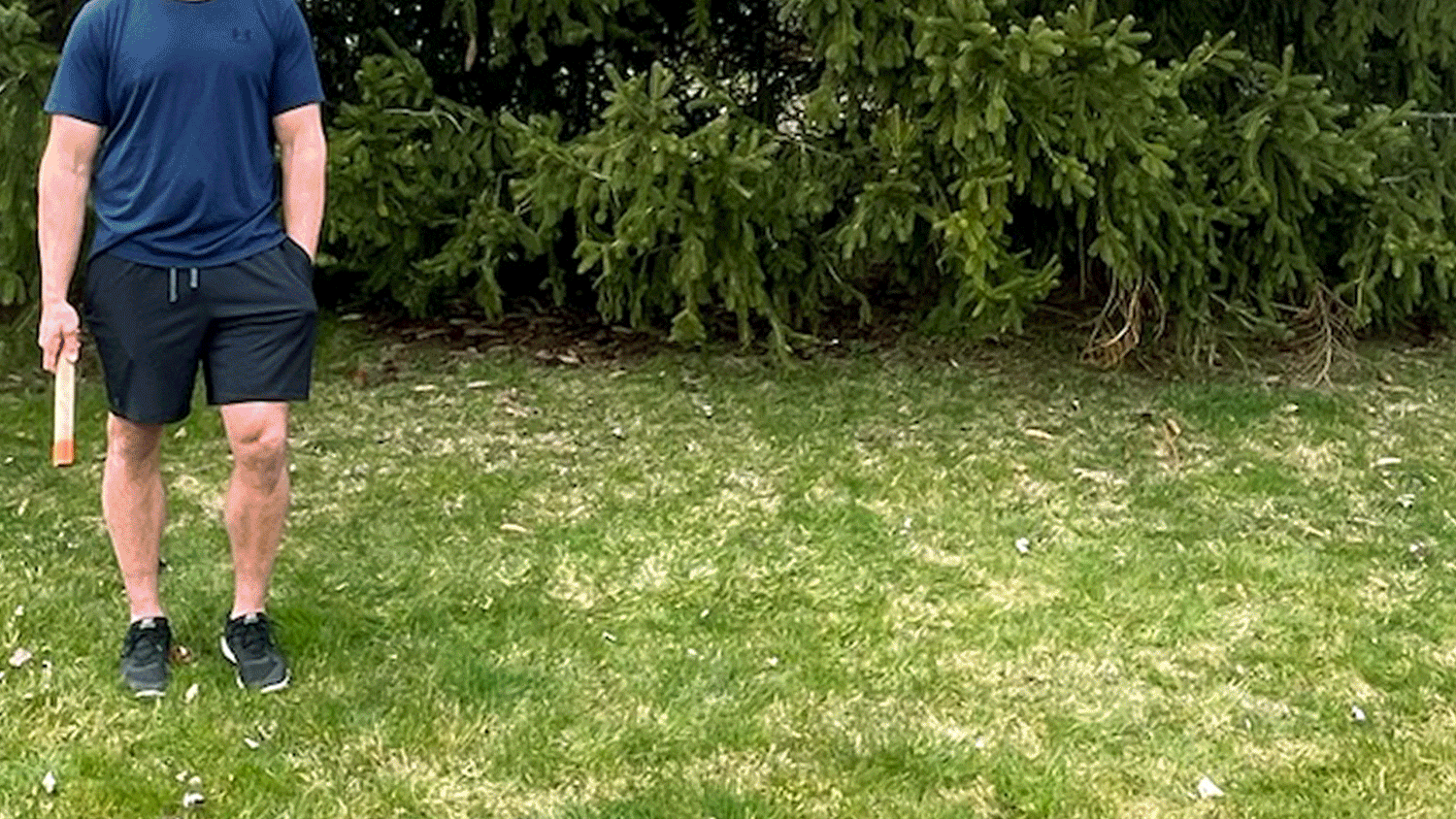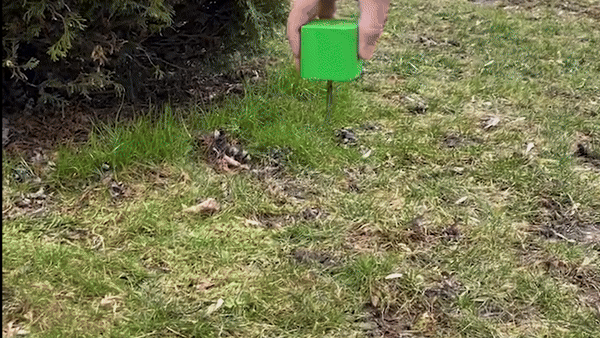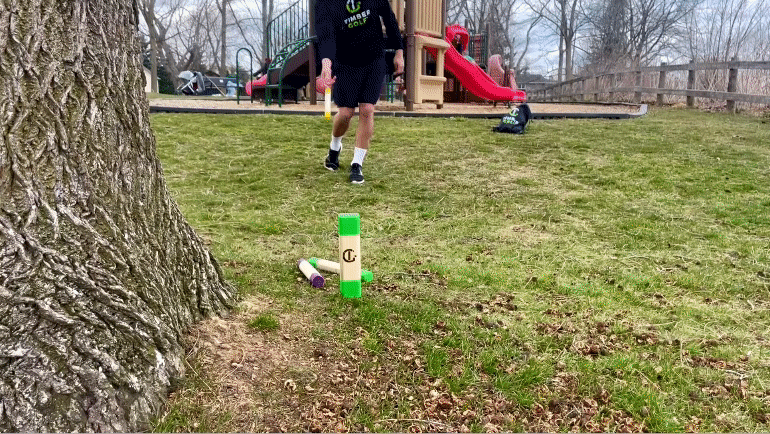
Step 1
Choose Your Players
Gather friends and family ages 7 and up! The Timber Golf Classic Game Set provides equipment for up to 6 players, and additional Timber Sticks are available for larger groups!

Step 2
Create Your Course
Create the course at the level of difficulty your group prefers by placing 10 Timber Holes at various distances in your playing area.
Increase the difficulty and fun by marking off areas where players' Timber Sticks cannot land using the provided out-of-bound markers.
Get creative with obstacles by using what you can find in nature (eg. bushes, trees, hills) or create your own (eg. boxes, trampoline, chairs).

Step 3
Tiiiimmmberrrrr
Time to start throwing sticks at blocks!
Win the game by knocking down 18 Timber Flags in as few throws as possible (Play 9 holes to one end of the course and then play those same 9 holes in reserve order).
If you ever knock a block in one throw, you must yell out, "Tiiiimmmberrrrrr!" as if you have felled a large tree. This is a rule.
★★★★★
"I was introduced to Timber Golf during a camping trip and we couldn't stop playing! Easy to learn and set up and you can change the layout so it never gets old, Timber Golf is now my go-to for outdoor games."
Allan | Ontario
Settle the Debate
Official Rules
Timber Golf Terms
Timber Flag: Green-tipped, logo-branded wooden blocks. This is the top of a Timber Hole.
Timber Green: Completely green, short wooden blocks with protruding metal spikes. This is the base of a Timber Hole.
Timber Hole: A Timber Flag and Timber Green pair, when players are trying to knock over its Timber Flag.
Timber Tee: A Timber Flag and Timber Green pair when players are making their drive (first throw).
Timber Stick: Paint-tipped square dowels in multiple colours, with which the players attempt to knock over the Timber Flag.
Shot: A throw of a Timber Stick.
Drive: The first throw of any hole is considered a player's drive. A drive may be thrown underhand or in a side-arm motion.
Penalty Stroke: Additional strokes added to a player's throw total due to rule infractions.
Out of Bounds (OB): Designated areas in which Timber Sticks must not land, wholly or in part. There are separate rules governing partial or full out-of-bounds Timber Sticks.
Out-of-Bounds Flags: Red plastic flags used to indicate OB areas.
Set-Up
- Place all 10 Timber Holes in your chosen outdoor space. This is your course. The Timber Holes remain in the same position for the entirety of the game.
- It is not necessary to create a loop. The first Timber Hole is the starting point. There are 9 more holes. This means there can be 9 holes to one end of the course and then you play those same 9 holes in reserve order, making your way back to the first Timber Hole.
- To maximize challenge and fun, placing the holes in hard-to-reach areas (under a tree, near water, etc.) is recommended.
- Create out-of-bounds areas by placing some or all the Out of Bound Flags (8 included).
- Players can designate additional out-of-bound areas by choosing well-defined lawn features (highly recommended). E.g. Gardens, driveways, tree lines, property lines, etc.
Alternative Set Up
- If you have limited space or time, we recommend trying an 8-hole course. Set up 5 Timber Blocks (instead of 10) and play by the same rules!
- If you are unable to place the metal spike into a surface where you’d like to position a hole, you can simply place the Timber Flag part of the Timber Hole on the surface, and set aside the Timber Green.
Game Play
Number of Players: The Timber Golf Classic Set includes enough Timber Sticks for up to 6 players. If you'd like to play with a larger group, additional dowels are available for purchase.
The game can be played individually or in teams. For individual play, each player competes on their own, aiming for the lowest score on each hole and, of course, the lowest total score. For team play, two or more players compete together using a scoring variation of their choice. Some recommendations are:
- Best Hole: Each player attempts to finish the hole in as few strokes as possible, but only the lowest individual score on each team is recorded for the team. E.g. Alisha and Bob are on a team. On hole 1, Alisha gets a 3 and Bob gets a 7. The team records a 3 for the hole.
- Best Stick: Each player drives. Each team decides which of their drives is best and all players take their next shots from the location of their team’s best drive. Repeat for each shot until the hole is completed. E.g. Alisha and Bob throw their drives. Bob’s Timber Stick is closer to the hole, so they decide Bob had the best drive. Alisha then picks up her Timber Stick and both she and Bob throw their next shot from the location of Bob’s Timber Stick. They repeat this 2 more times. On the third time, Alisha knocks over the Timber Flag. The team records a score of 3 for the hole.
Player Safety: Players shall ensure that all throws are attempted away from buildings and when all players and/or bystanders are clear of the potential landing area of the Timber Sticks to prevent accidents or injuries during gameplay. DO NOT throw the Timber Holes and ensure the Timber Greens are always either in the ground or covered.
Objective: Players aim to knock the Timber Flags off the Timber Green by hitting the Timber Flag, directly or indirectly, with their Timber Sticks. Like golf, the objective is to complete each hole in the fewest shots possible.
Throwing: Players must throw their Timber Stick underhand in an end-over-end motion unless it is their drive.
Starting Position: Play begins at the first Timber Tee. The first throw is in the direction of the next Timber Hole (the second Timber Flag/Timber Green pair).
Driving Position: Each player throws their Timber Stick from within a 1-yard by 1-yard area behind the current Timber Tee. This is the Yardbox. The front of the Yardbox begins at the front of the Timber Tee and is centred from left to right.
Players may start outside of the Yardbox, but may not release their Timber Stick until at least one foot is fully planted within the Yardbox. The player’s other foot may plant on top of a side or rear boundary of the Yardbox during or after the throw but is not required to be planted.
See Throwing Faults for more details.
Drive: The first throw of any hole is considered a player's drive. A drive may be thrown underhand or in a side-arm motion.
Throwing Position: All subsequent throws following the drive must be thrown from the landing position of the player’s Timber Stick. Both player's feet must be planted, no wider than shoulder-width and their toes no closer to the hole than the closest point of their Timber Stick. This is to prevent a player from moving their body around an obstacle, for instance.
Throwing Faults: Players must maintain proper footing while attempting their starting throw (drive) and subsequent throws (shots).
- Driving Fault: Players may start outside of the Yardbox, but may not release their Timber Stick until at least one foot is fully planted within the Yardbox. The player’s other foot may plant on top of a side or the rear boundary of the Yardbox during or after the throw but is not required to be planted. However, a Player HAS committed a Driving Fault if any of the following occurs at the time of release. 1) One of their feet is not fully planted within the Yardbox, 2) One foot is fully planted outside of the Yardbox, or 3) One or both feet are planted on or past the front boundary of the Yardbox. A Player HAS also committed a Driving Fault if any of the following occurs after the release of the Timber Stick: 1) Any planted foot slides through the front boundary, 2) Any planted foot fully leaves the Yardbox through any side, or 3) An unplanted foot is planted outside the Yardbox in a player’s effort to maintain their balance or otherwise. In any case, a player has NOT committed a Driving Fault if it is obvious to other players that the Timber Stick was released unintentionally (e.g. A player accidentally drops the Timber Stick).
- Subsequent Throw Faults: During subsequent shots, players must place both feet on the spot where their Timber Stick comes to rest, with their feet no further apart than the length of a Timber Stick, and with no part of either foot closer to the Timber Hole than the closest part of their Timber Stick. A player may not remove either foot from the throwing position until it is clear they have maintained their balance following the throw.
Throwing faults result in a one-stroke penalty.
Establishing Foot Position: If a player cannot establish a legal foot position (eg. their Timber Stick landed in a bush), they must take a one-stroke penalty. The player must then pick a new spot where they can establish a legal foot position. This new spot must be as close as possible to where the Timber Stick landed, and no closer to the hole than where the Timber Stick landed.
Disturbing Timber Stick Placement: A player may not pick up their Timber Stick until it is their turn. If a player’s Timber Stick is moved by another player's throw, where their Timber Stick came to rest is considered their new position. In the case where one or more Timber Sticks are resting on other Timber Sticks, the topmost Timber Stick shall be played first. Players must remove their Timber Stick from play after knocking over the Timber Flag and before the next player throws their Timber Stick.
Shot Order:
- Starting Order: At the beginning of each game, players determine the order of throws by shooting their dowels towards an agreed-upon object on the lawn. The player whose dowel comes to rest closest to the agreed-upon object throws first (drives), and the player whose dowel is furthest away from the object throws last.
- Subsequent Shots: After everyone drives, the player furthest from the hole throws next, regardless of throws already completed.
- Subsequent Hole Starting Order: Following the first hole, players shoot in order of the lowest number of shots taken on the previous hole, to the highest number of throws. If there are any ties, then all players with the same score shoot in the order that they shot on the previous hole.
- E.g. On hole 1, Ernest shot first and Lottie shot 4th. If Ernest and Lottie both get the best score on hole 1, resulting in a tie, Ernest would still shoot first on hole 2, and Lottie would now shoot second.
Foot Position Advantage: At any time, instead of throwing their Timber Stick and knocking over the Timber Flag, a player may attempt to reach out and touch the Timber Flag with their Timber Stick to end their turn. Touching the Timber Flag counts as their final stroke. To be considered legal, the player must be standing from a legal throwing position, they must not lose their balance, and they must not use any part of their surroundings, especially the Timber Flag, to maintain their balance. If any of these criteria are not met, the player will receive a penalty stroke. The player may attempt this as many times as they wish but will receive a penalty stroke for each attempt in which a fault is committed. Simply not being able to touch the Timber Hole is not a fault, and does not incur a penalty.
Hole Completion: A hole is considered completed if any one of the following conditions is met*:
- The bottom face of the Timber Flag is no longer contacting any part of the top face of the Timber Green.
- The entire Timber Hole is knocked over.
- A player legally achieves a Foot Position Advantage.
*It doesn’t matter whose Timber Stick actually contacts the Timber Hole. It only matters who threw the Timber Stick that resulted, directly or indirectly, in a hole completion. Eg. If Dan throws his Timber Stick into Selena’s Timber Stick and Selena’s Timber Stick knocks over the Timber Flag, Dan is credited with completing the hole. Selena must then take her next throw from her Timber Stick’s new resting position.
Timber: If a player knocks down the block on their first shot attempt of the hole, it is known as a “Timber.” Players are encouraged to yell, “Tiiiimmmberrrrr!,” as if they have felled a large tree. This is a rule. If a player does not yell this before the next player completes their toss, they receive a one-shot penalty because in Timber Golf, FUN IS MANDATORY!
Subsequent Holes: Once a hole has been completed, that Timber Hole becomes the next Timber Tee.
Completion of the Round: The front 9 holes are played in order. After completing the 9th Timber Hole, the 9th Timber Hole becomes the 10th Timber Tee. The direction of play turns 180 degrees and the front nine is played in reverse order (starting from the 10th Timber Tee). The game ends after all 18 holes are completed.
How to Win & Tie-Breakers
Winner: The player who achieves the lowest score after completing all 18 holes is the winner of a Timber Golf game. The goal is to finish the course with the fewest shots possible, and the player with the lowest overall score takes the victory. If alternative scoring is used then the player with the highest points wins.
Closest to the Block Challenge: In the event of a tie between two or more players after completing all 18 holes, a "Closest to the Block" challenge will be used to break the tie. For the tiebreaker, players involved in the tie will select a designated hole (either a specific hole or a new hole) as the tie-breaker hole. They will take one additional shot each, aiming to get their Timber Stick as close to the Timber Hole as possible. The player whose Timber Stick comes to rest closest to the block will be declared the winner of the tiebreaker and, consequently, the winner of the game.
Scoring
Scoring: After each hole, every player will record the number of shots they took to complete the hole (including penalty strokes). At the end of the game, players add up all of their shots to get a total score.
Alternative Scoring: After each hole, the player with the lowest number of shots for that hole gets 1 point. If the lowest score is set by multiple players, they each receive 1 point. If it took every player the same number of shots to complete a hole, no points are awarded. At the end of the game, players add up all of their scores from each round to get their total points.